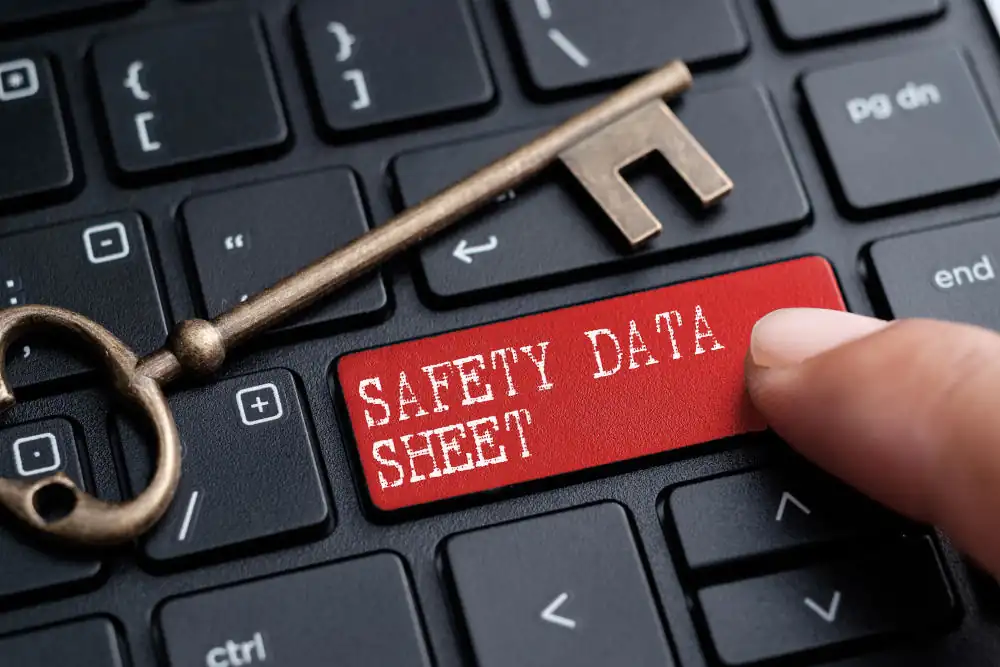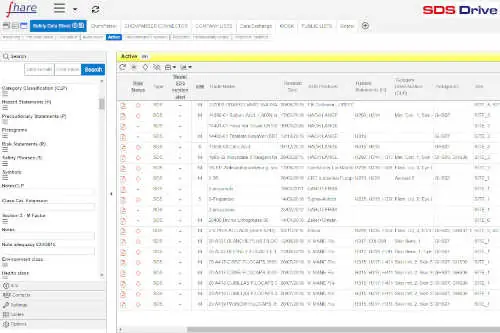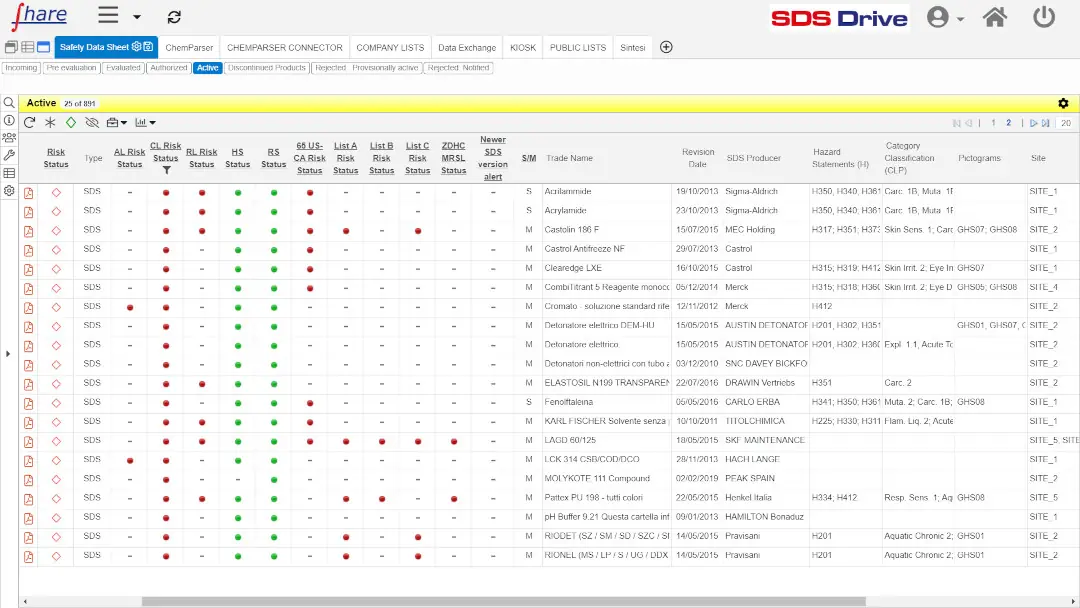Centralized SDS collector and manager
The Solution for HSE, H&S, Sustainability Manager, Reach and Regulatory Manager
Organized management and centralized storage of Safety Data Sheets (SDS) in use in your company
The archive of Hazardous Substances in the company
The solution for keeping chemicals under control
SDS-FullService supports HSE, H&S, Sustainability Manager, Reach and Regulatory Manager in the management of Safety Data Sheets and control of chemicals.
It is a simple and effective system for storing SDSs, searching them based on the information they contain, and sharing them with all relevant business functions, sites, and departments.
Centralized, organized, up-to-date, internet-accessible archive of your SDSs
Historical archiving of obsolete SDSs or products no longer in use
Search capabilities possible for all digitalized data in your Chemical Inventory
Standard distribution of SDSs to users
Simplified access to streamlined SDS, including through departmental kiosks
Configurable processes for document and data flow (validation cycle, approval, etc.)
Integration of public (ECHA, California Prop. 65 and others), private and industry lists to detect and track the presence of hazardous and/or unwanted substances
(You must accept "Experience" cookies to view the video properly)
The main features of SDS-FullService
Automatic data extraction from SDSs for enhanced analysis
Automatically extract salient information from SDSs to work more smoothly.
All SDSs in a single repository
Put SDSs in order and find everything you are looking for right away.
Improved control of internal processes
Set up structured processes to have full control over the SDSs received.
View the differences between a new version of an SDS with previous versions.
Effective management of SDS availability in the company
Make Safety Data Sheets available to the users, sites and departments involved.
Supplier Collaboration
Communicates SDS nonconformities with suppliers/manufacturers.
Control of hazardous substances
Expand the possibilities of analyzing SDS data by cross-referencing them with those from public or private databases.
Data Export and Reporting
Exports data in various formats and generates both Interface and Scheduled Reports
API / Web Services
Integration with other applications via API / Web Services
Enhanced data analysis: automatic SDS extraction and indexing
(You must accept "Experience" cookies to view the video properly)
SDS-FullService is able to associate each document with the information it contains thanks to our technologies of automatic extraction and indexing of the data.
Indexing works by transforming SDS into easily searchable and assessable digital data, making SDS a tool with which to work easily.
Data are not manually uploaded (a very onerous task) but automatically extracted from SDSs thanks to our method of working with ChemParser, a technology specially developed in order to drastically reduce time and errors of manual loading.
We extract data from sections 1,2 and 3 of the SDS and supplement it with data needed for your management process or, for example, with information useful for Chemical Risk prevention and assessment.
What data is automatically extracted from the Safety Data Sheets (SDS)?
Below is a table of "standard" data extracted by section. Additional information can be extracted based on specific requests made by client companies
Section 1
Identification
- Name of the substance or mixture (trade name, mixture name)
- Date of revision
- Language
- Product Type (Substance/Mix)
- Name of manufacturer
- UFI Code
- Relevant and discouraged uses
Section 2
Hazard Identification
- CLP Classification/Category
- Pictograms
- Warning
- H phrases (hazard statements)
- P phrases (cautionary advice)
Section 3
Composition / Component information
- Substance name/designation
- CAS number, EC number, Index, REACH registration number
- CLP Classification/Category
- H phrases (hazard statements)
- Concentration ranges (Range %)
- M factor
- Notes
Yours Safety Data Sheets In one place: storage and searches
With an organization based on panels that can be broken down by progress in the approval workflow, product type, different levels of confidentiality, and classification indexes, SDS-Drive (a module of SDS-FullService) offers a new level of efficiency over the entire process of archiving and consultation of Safety Data Sheets.
Each panel also has the corresponding "Obsolete" panel to archive SDS versions replaced by new Revisions for the 10-year retention required by the regulations.
Each document stored in SDS-Drive, moreover, is easily searchable by taking advantage of any combination of index data that characterizes it. For example, it can be searched through:
-
-
- Name of manufacturer
- Name of the substance or mixture
- Substance identification codes (EINECS, CAS Number and Index)
- REACH registration number
- Date of revision
- H Phrases (Hazard statements) and P Phrases (cautionary statements)
- Pictograms
- Components of mixtures
- Range % (for mixtures)
- CLP Category Classification
- ... and much more!
-
Improved control of internal processes
Management of validation, approval, and distribution processes for SDSs received via Workflow
The process of managing and distributing SDSs is fundamental to workplace health and safety. To meet the diverse needs of all organizations, the process is customized and guided through workflows.
With SDS-FullService, workflows can be configured to manage the processes of:
-
-
- update
- validation
- approval
- adoption by H&S of establishment
- distribution of SDSs to users
-
(You must accept "Experience" cookies to view the video properly)
Quickly visualize the differences between two SDSs: Work only where you need to!
(You must accept "Experience" cookies to view the video properly)
Different actors in the SDS approval workflow mayneed to compare different versions of an SDS in order to quickly find changes that have occurred.
To address this need, SDS-FullService, during the various stages of the SDS management process, provides a feature that makes it easy to compare PDFs of documents.
For example, it may be of interest to see the differences between:
-
-
- document in use and its revision under evaluation
- document in use at the plant and its revision being adopted
- document in use and an earlier version filed under obsolete
- document of a new product that is a replacement for a product in use and that the supplier claims is "virtually the same"
-
In addition to during the SDS approval cycle, this feature can be used any time you need to evaluate the differences between two different versions of an SDS.
Effective management of the availability of Safety Data Sheets (SDS) in the company
Making SDSs available to all users at the various company sites
Making the correct information contained in SDSs available to workers is not only a duty for the person in charge, it is an employer 's obligation enshrined in the Occupational Health and Safety Consolidation Act (Legislative Decree 81/2008).
With structured internal distribution processes, SDS-FullService is able to guarantee access to both documents and data within their competence to all relevant users at the various company sites (H&S; R&D; Medical Officer, workers in the department, ...) .
The HSE/H&S maintain full control over the actual documents at each site, both domestic and international, and are able to verify the level of update and the presence of SDSs in the required languages.
(You must accept "Experience" cookies to view the video properly)

Supplier Collaboration: communication with suppliers and manufacturers
SDS-FullService also enables more effective management of communication with suppliers/manufacturers
This feature, called Supplier Collaboration, gives the ability to send an email to the supplier/manufacturer whenever an SDS nonconformance is found.
Full control of the database of hazardous substances in the company
Integration of external Databases to monitor your hazardous substances
Within SDS-FullService, it is possible to integrate public lists of substances, such as the main ECHA Databases, and also industry databases, as well as additional lists of substances that the company intends to replace or monitor.
Here are some examples of public and private databases and lists of (banned or restricted) industry substances:
-
-
- ECHA Candidate List
- ECHA Restriction List
- ECHA Authorization List
- ECHA Registered Substances
- ECHA Harmonized List
- MRSL ZDHC
- Private MRSL (customer specifications)
- OEHHA California Proposition 65
-
Cross Reference features to improve control
The Cross Reference feature identifies and marks all your chemicals that contain substances included in the integrated lists (one or more) that are of interest to you.
Regularly, the Cross Reference Report feature informs managers by sending reports with reports on changes that have occurred, namely :
-
-
- If a substance (or component of a mixture) in your chemical inventory has recently been included on one of the lists
- Whether the entry of a new SDS or its update includes one or more substances on the lists
-
This means being able to be constantly updated on the changing hazardous conditions of their products and being able to take timely action on prevention and protection measures.
Main Databases Integrated in SDS-FullService

- Candidate List (SVHC): list of candidate substances for inclusion in authorization.
- Restriction List: list of restricted substances (Annex XVII of REACH).
- Authorization List: list of authorized substances (Annex XIV of the REACH regulation).
- Registered Substances: list of registered substances as per REACH regulation.
- Harmonized List: list of harmonized substances (Annex VI of the CLP Regulation).
- POPs List: list of persistent organic pollutants (Stockholm Convention).

California Proposition 65
OEHHA (Office of Environmental Health Hazard Assessment) CA-65: list of natural or synthetic chemicals that are carcinogenic, mutagenic or reprotoxic

Zero Discharge of Hazardous Chemicals
ZDHC MRSL: list of restricted substances in the textile, tanning and footwear industry
- Drug precursor: list of drug precursors (European Commission Regulation No. 2023/196).
- Chemical Weapons Precursors: list of chemical weapons precursors as per EU Regulation 218/1544

Data Export and Reporting
SDS-FullService provides specific functionality for data export and report generation.
Exports can be done in various formats, such as Excel, CSV, XML, JSON.
Reports can also be obtained in various formats, such as Excel, Word, and PDF.
Selection of documents to be processed can be done via interface, choosing individual documents, or applying search parameters, including multiple ones.
Reports, in addition to being callable from the interface, can also be scheduled and automatically sent to interested recipients.
Some reports, those most frequently requested by our clients, are already available in a standardized format. For additional needs, "custom" reports can be produced.

API / Web Services
SDS-FullService offers the ability to be both powered and queried via API/Web Services.
This functionality allows integration with other business applications, enabling the automation of processes regarding Safety Data Sheets (SDS), which, by being able to send and receive data in real time, enables improved efficiency and accuracy of SDS management.
For example, with APIs it is possible:
- The automatic entry of new SDSs into the SDS-FullService database directly from other applications
- Synchronization of SDS data with connected applications so that all information is always up-to-date
- Querying to retrieve specific information on SDSs, thus supporting analysis and business decisions in a timely manner
To learn more details regarding the SDS-FullService API, you can access their technical documentation at the following link.
Benefits of SDS-FullService Cloud Solutions.

24/7 Availability
Available 24 hrs a day, 7 days a week. Access information when you need it, wherever you are.

A scalable and rapidly deployable solution
Available in different configurations suitable for all companies, including with SSO to automatically provide and revoke access to employees.

Ease of use
Use the service immediately, without training activities.

Rapid return on investment
Reduce time-consuming manual tasks and automate SDS management.

Tutorial & Interface
Multilingual interface, Tutorial with movies illustrating the operation of the service.

Low cost of ownership
With no software to install or maintain, with immediate access to new implementations and features.
Our team is here to help you manage SDSs and keep track of hazardous substances!
SDS-FullService for the management of Safety Data Sheets (SDS)
Indexing of SDSs
Automatic extraction and digitalization of information from Safety Data Sheets (SDS)

Centralized SDS collector and manager
Centralized and up-to-date binder of your Safety Data Sheets (SDS): the whole company can access and manage chemical data
Ongoing monitoring of MRSLs
Continuous monitoring of your hazardous substances with cross-checking against MRSLs of interest to you and automatic notifications of changes that have occurred
Access to SDSs for all users
Access to SDSs for all workers and authorized users
Automatic delivery of SDSs
Automatic and secure delivery of SDSs to customers and all product recipients, complies with REACH reg. and CEFIC, FECC and DUCC recommendations
Searching for and uploading SDSs
We retrieve missing SDSs or necessary updates by contacting the supplier
Start up services
we digitalize, we survey and catalog the SDSs present in the company, eliminating duplicates, unnecessary and obsolete ones, as well as searching for missing SDSs and new versions
Professional Services
The services of our Chemical Regulatory Partners: a team of REACH, CLP, environmental regulations, health and safety experts














